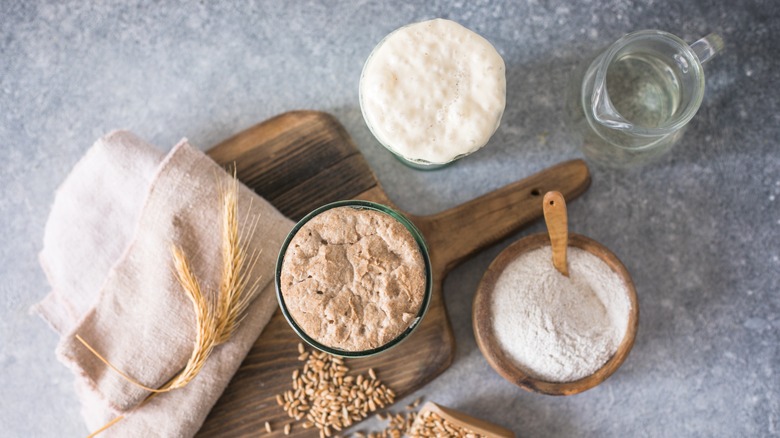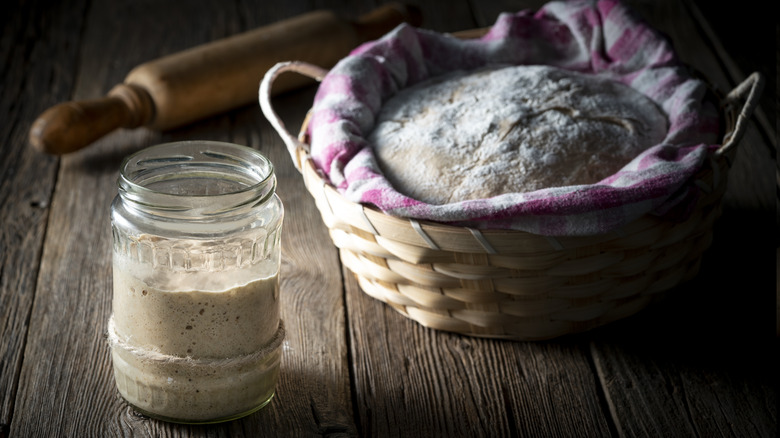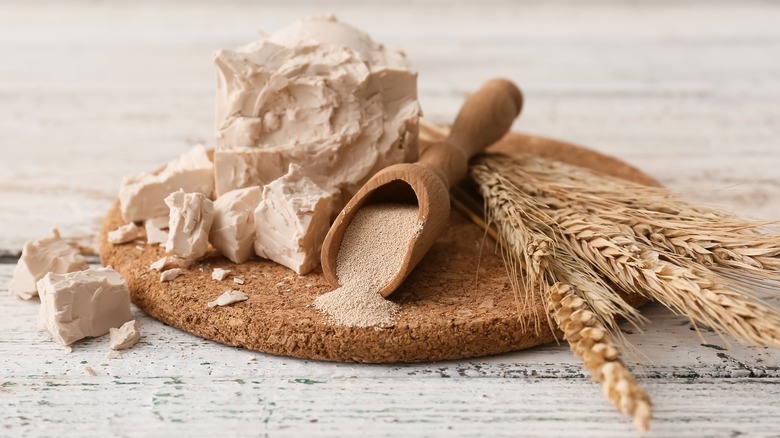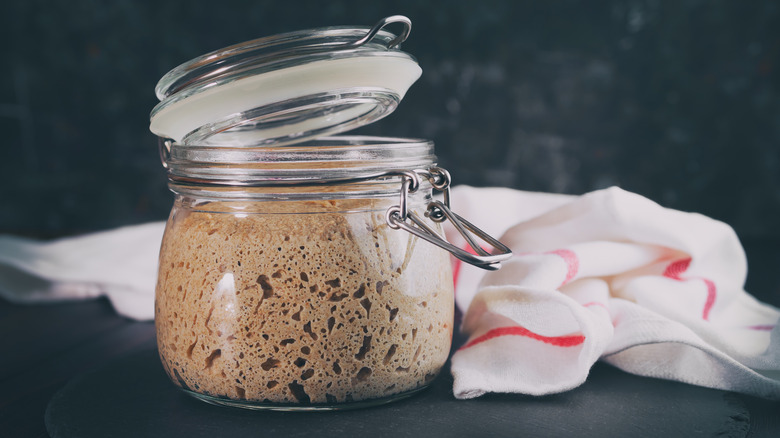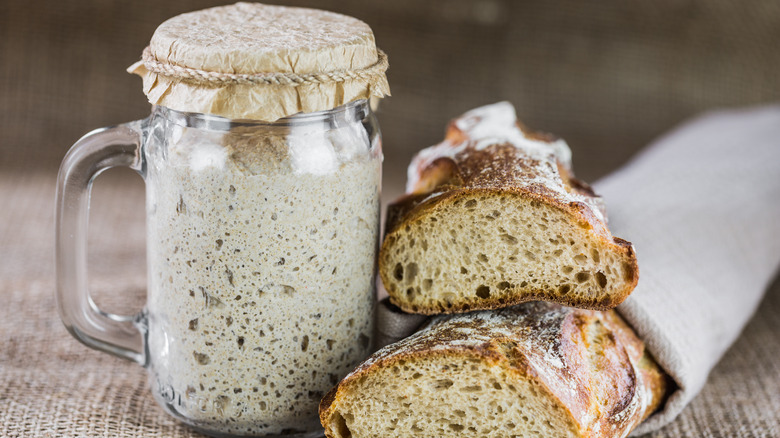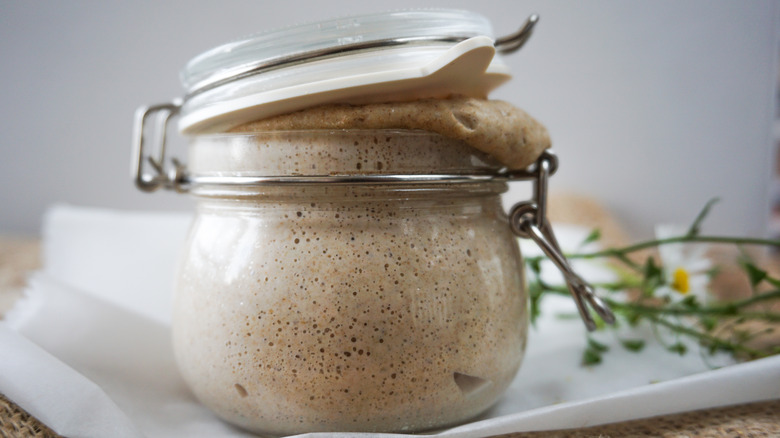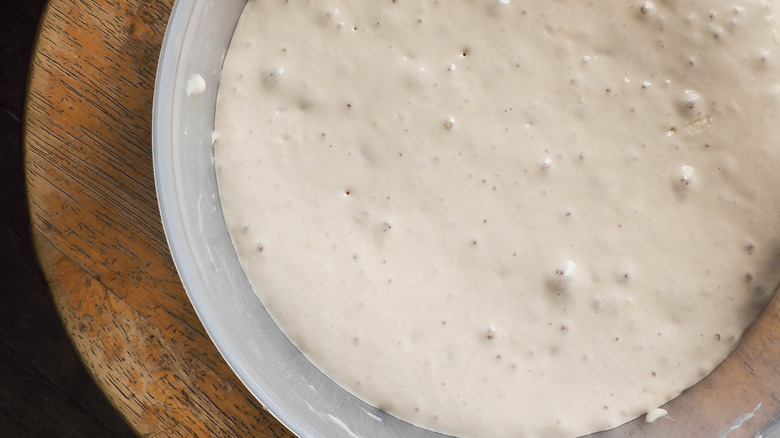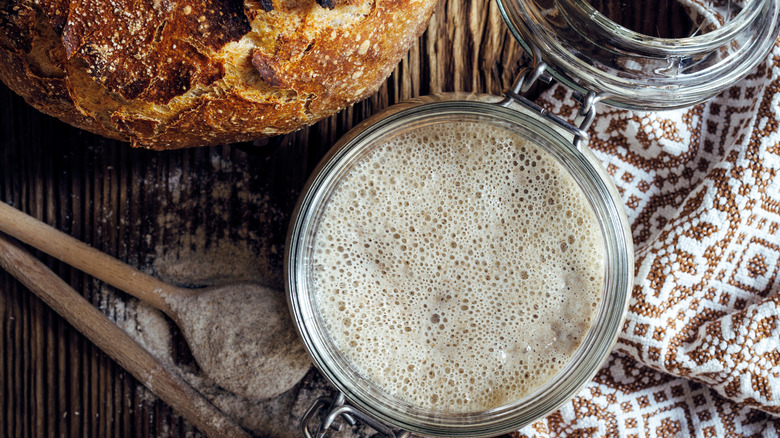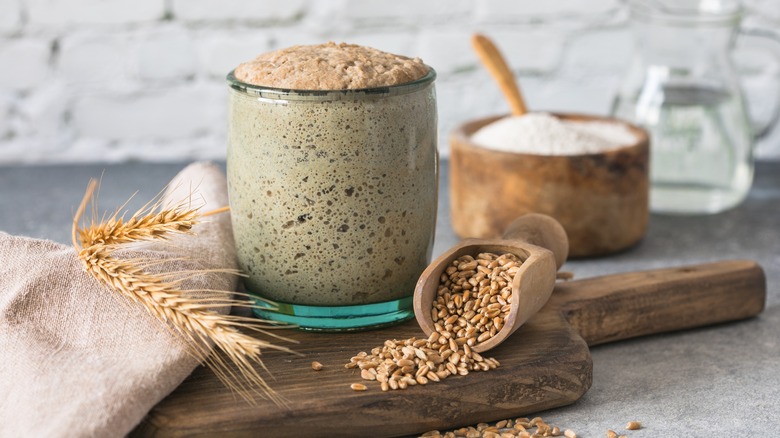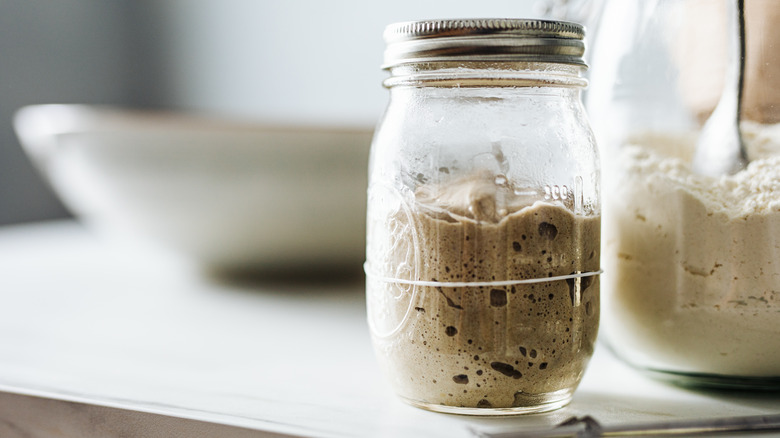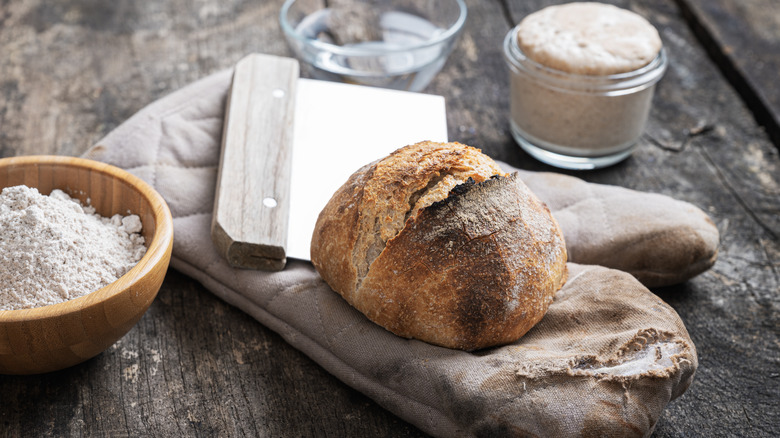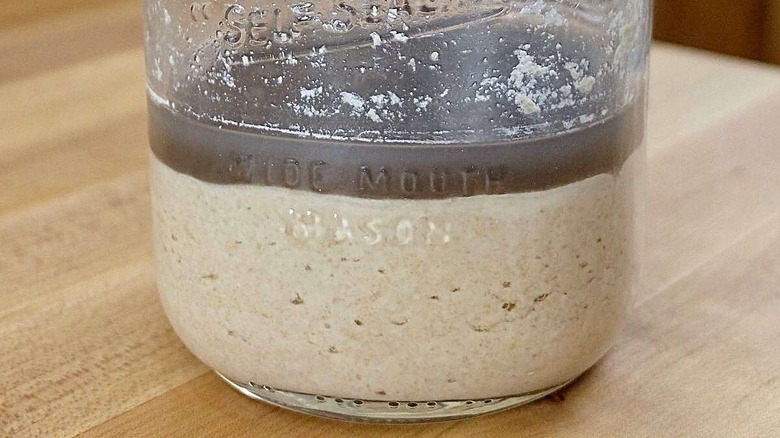Essential Types Of Bread Starters And How To Create Your Own
In bread making, one of the most crucial elements is a starter. A starter is a leavening agent in bread in place of additional yeast. Starters are created by allowing wild yeast and friendly bacteria called lactobacilli to ferment. An active starter is what creates air pockets and makes bread rise without using additional yeast, such as the little packets of instant yeast.
The use of starters is long-standing, including one over 4500 years old found in an Egyptian tomb. Scientists were able to revitalize the starter and bake bread. Whereas most sourdough is characterized by its namesake sourness, the Egyptian loaf was described as "much sweeter and more rich" (via GlobalNews).
When considering creating a starter, sometimes called a "preferment," it is sometimes the sour or tangy flavor that deters people. Funnily enough, sourdough does not have to be sour, nor is this always a desirable flavor. When creating your own, one of the benefits is being able to control your flavor profiles. Controlling the ripeness or maturity of your starter are some factors that determine the tartness of your flavors! Making your own starter can look daunting, but creating it can be fun and uncomplicated. With a little time and effort, you can have your own starter and customize your flavors. A little patience will have you baking your own delicious bread and more!
Fermentation and its benefits
Creating your own starter is like creating a new pet, like Dr. Frankenstein without the torch-wielding masses. You, too, can yell "it's alive" as you watch your starter grow. Depending on how often you feed your starter, it will continue to grow and make bigger bubbles. What those bubbles mean in bread baking is how "ripe" tasting your bread is and how big the holes in your bread will be. For some people, those larger bubbles are not desirable. In artisanal bread, the large holes indicate a rich, full-bodied flavor and good bake. Other breads, though, will have a tighter crumb, meaning smaller holes. It is up to you!
Fermentation, the process of creating a starter, not only allows you to control your own flavors but has many other added benefits. People have been using fermentation to create yogurt, kombucha, cured meats, kimchi, or pickled vegetables as methods to extend the life of foods or create more flavor. Just like a good head of foam on your beer, you want your bread starter to be full of burping bubbles!
One of the most amazing benefits of your own starter and bread is that some gluten-sensitive people are able to eat sourdough or other starter-based bread with no sensitivity issues! Sourdough bread is easier to digest because the fermentation neutralizes antinutrients found in grains and breaks down gluten proteins, according to Healthline.
Types of yeast
As previously stated, yeast is the leavening agent that makes your bread rise. While all yeast started wild, there are several options available even without capturing your own wild yeast. Even when using a starter, some recipes will still include yeast. You may also see recipes using starter discard, which is what you get after feeding your starter.
Your local grocery store most likely has a few different packets and jars, but what are the differences? There are commonly three types of yeast: dried, instant, and fresh. Dried yeast, the little packets of powdery yeast, is the most widely used because it is easy to store and convenient for baking. Dried and instant yeast are essentially interchangeable; both need to be rehydrated in warm water before use, but instant yeast reconstitutes faster.
Fresh yeast is a little more difficult to find. It comes in a moist cake and is traditionally preferred by bakers. It does not have to be reconstituted but does have a shorter shelf life. Fresh yeast is said to have a better flavor compared to dried or instant, but you can decide what works best for you.
It is this wild yeast that is also one of the essential elements in creating bread starters. With a starter, you don't need either dried yeast or cakes of fresh yeast for some recipes, as it works in place of both.
Wild yeast
What is wild yeast? Why does it matter, and do you want to catch it? Let's start at the beginning and take it nice and slow. Yeast is a microorganism that lives all around us. Yeast thrives on carbohydrates (just like some of us) releasing alcohol and carbon dioxide. Yeast in the fermentation process is what creates leavening, or rising from the release of the carbon dioxide and alcohol. Yeast burps make bread and beer!
Now, let's capture some of those cute little gas releasers. There are a few ways to start your own, so Grab a net, and let's go! Seriously — you will need a fine cloth like cheesecloth along with fruit, a jar, and some water.
To create your own mash (the precursor to a starter), bakers choose to capture yeast using either fresh or dried fruits. Either way, you're going to let the fruit rot on purpose. We know it sounds weird but stay with us. Put the fruit in a tightly sealed jar with clean water and store it. You are now creating yeast water! The water is ready to use after it begins to bubble and is frothy. This takes about five days, so be patient with your new buddy.
You have now captured wild yeast, and you can now use this water in place of baker's yeast (the little dried yeast that comes in packets) and the liquid in a recipe.
Basic sourdough starter
You've now captured your own wild yeast, but that's not a starter yet. If you read through various recipes, starters can be an extremely complex process. Professional bakers will talk about ratios — how much water to flour, which flour or flour combinations work best, and so on. It can be overwhelming. We got you!
First, though, we need to make your starter. While we can talk a lot about ratios, we're not going to. You're welcome. The simplified version of why you see ratios is because baking is a science. Professional bakers use weight in their recipes because weight is more precise than volume. Ratios allow for consistency, which is crucial for baking.
We're going to discuss simplified volume and weight since we're making our starter on a small scale. Either option will result in an easy-to-make starter. Creating your own starter can actually be easy but does take time.
To make your first starter, you will only need a large clean jar, flour, and water. If you're doing this by weight, you will want an inexpensive kitchen scale that includes grams and a "tare" option. Tare removes the weight of the container, making your display zero. After you've grown a starter, you get to name it too! Ours is named "Burpy" because we're immature adults, not because we love exercise. No one likes burpees.
Levain
A levain is another form of a starter and is often used interchangeably. Both sourdough starters and levains utilize wild yeast but a levain typically is made using a portion of a starter.
A levain can add quantity if a recipe calls for more starter than you have. A levain is also used by bakers to try flavor changes for a one-time bake instead of altering the entire mother starter. The other advantage is that a levain can be used both with your starter and in place of one. Instead of taking days to create or feed a starter, a fresh levain can be produced in about 12 hours. (To make a faster levain, you will need an existing starter, though.)
The biggest difference between a starter and levain is that levain is completely absorbed in the baking process whereas you only use a portion of your starter in a recipe. You never want to use up your entire starter; always reserve at least a few tablespoons. If you use the entire starter, you will have to start a new one.
Even if you use a starter, a levain can be useful because it does not depend on flour types. Since levain works as a leavener, any type of flour can be used. Using different flours is one way to alter your flavor profiles and textures in your finished loaf.
Poolish
A poolish is another type of preferment but uses commercial yeast. Whereas a sourdough starter is thick and almost glue-like, a poolish has a looser consistency. A poolish is made from equal measures of flour and water. The resultant gloop is allowed to ferment at room temperature until it bubbles and increases in volume. A poolish is considered mature when the volume begins to recede and has a slightly wrinkled surface.
A poolish is used to make French bread and other French baked goods because it creates more complex flavors while extending the shelf life of the bread and making it softer.
The biggest benefit for a home baker is the time it takes to make a poolish. You can start a poolish overnight and be ready to use it in the morning. A poolish takes on average 12 to 18 (and sometimes up to 24) hours to mature, unlike a starter that can take days to either make or bring back to being ripe if left unfed.
Another possible advantage of poolish is the flavor. A poolish is not as sour as a levain or starter. For some people who don't care for the sourness of sourdough, this is an advantage. However, like a levain, a poolish will be used in its entirety for a bake.
Bigas
Bigas are another type of preferment. Like a poolish, a biga can be made overnight. However, a poolish is considered high hydration, being made with equal parts water and flour. A biga has only about 45% water to flour hydration, resulting in a firm and elastic mix. A biga is most commonly used in Italian bread baking where a crisp crust and chewy interior are desired, as in focaccia or pizza dough. A biga creates a tight, dense crust.
Aside from the texture of the resulting bread, a biga may be preferred by some due to the flavor profile. Where a poolish adds a tangy flavor like in a French baguette, a biga is considered sweeter and more complex. Both mixtures are single-use.
What happens, though, if we combine a poolish with biga? Adding both in equal parts results in a complex, interesting bake. The resulting bake has an open crumb and lighter texture, giving your bread the best of both worlds! One of the most amazing things about baking with a preferment is how easily they can be adapted into other recipes!
Creating your own sourdough starter the easy way
Now that you have an idea of the various types of starters, let's make a sourdough starter! To make your first starter, you only need a large clean jar, flour, and water. The easiest starter is one we have used for years because it's not only easy but also reliable and accessible. Baker Zachary Golper's starter is great because he walks us through the entire starter process. Golper's recipe uses rye flour and uses weight measurements. You can do it — we got you! Making your starter is a seven-day process, but most of that time is letting it grow.
You can use whole-wheat flour or rye initially, then all-purpose (AP) or bread flour for feedings. The one thing to keep in mind when using AP or bread flour is to read the label. Avoid any brand that includes "potassium bromate." The FDA considers bromate non-harmful and used as an oxidizer that "ages" flour making it rise faster. This might sound great, but bromate is illegal in countries like Brazil, Canada, and the EU because it has been shown to cause cancer (from Live Science).
Tips and tricks to feed your new starter
The biggest issue regarding starters is the time involved. With all the discussions regarding ratios, varieties of preferments, or what type of flours should be used, it is almost always time that deflates those who want to make prefermented bakes.
While there is an amount of planning involved, creating and using your own starter is not that complex! Once you have made your starter, you've done the hardest bit. Maintaining and using your starter is where the real fun begins.
Consider how you plan on using your starter. You actually don't have to bake only bread with your starter. There's a huge world of recipes that use your discard that aren't bread, including crackers, brownies, pancakes, cookies, and biscuits. We've been baking sourdough for years and know many bakers who maintain a starter just for the discard!
Once you've made your starter, it needs to be refrigerated if you won't use it on a daily basis. While your starter will go inactive, it only takes a few days or hours to reactivate. One of the amazing things about a starter is how resilient and tough to kill it is!
Using your starter
You've got your bubbling, mature starter, so now it's time to do some baking! One of the tastiest recipes is an easy country loaf. For a new baker, artisanal loaves are a great option because they require a limited amount of shaping and tools. Even for more advanced bakers, the peasant or country loaf is a great go-to recipe. As you get more confident, you can add fun tools like scoring knives or shaping baskets to your arsenal.
With your active starter, you can bake pretzels, croissants, bagels, dinner rolls, bagels, and more! Even between feedings when your starter isn't active, you can make an almost endless array of goodies.
After using or after your starter has gone inactive, you will need to "discard" a portion of your starter before feeding it. When we were first learning to make sourdough bakes, we were told that if you don't discard some of the old starter, you will eventually end up with enough starter to fill a swimming pool. Ew.
When discarding, never, ever put the discard down the sink. The discard can grow and clog your pipes. Also, that discard is as precious to use in recipes as the starter itself!
Storing your starter
If you have let your starter become inactive and see an orangish or pink tint, discard the entire batch and start over. The pink or orange tint means unwanted types of bacteria are growing on your starter.
Alternately, if your inactive starter has either cloudy or blackish water on top, this is called hooch. No worries! Some bakers stir the hooch back into their starter while others say to pour it off. If you have about an inch in a quart jar, it is suggested to pour off the liquid. This liquid "hooch" is an indicator that your starter is hungry and could use some love. (Note — this is not hooch as in moonshine, so don't drink it.) An extremely neglected starter will develop mold. If mold does occur, the entire batch needs to be thrown out.
If you want to store your starter long-term or know you won't be using your it for a while, you can freeze it. Freezing some of your starter even if you use it often is also insurance against accidents, such as a starter turning bad, dropping, or otherwise becoming contaminated. Once frozen, the starter becomes dry, brittle, lightweight flakes. Not only is freezing your starter a great way to protect it against accidents but the flakes can be shipped to a friend who can reconstitute the starter and use it, too! Starters have actually been shared all over the world in recipes like Amish bread, also called friendship bread.

